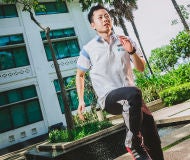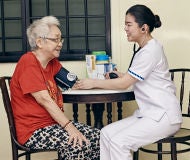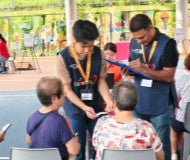Singapore General Hospital will NEVER ask you to transfer money over a call. If in doubt, call the 24/7 ScamShield helpline at 1799, or visit the ScamShield website at www.scamshield.gov.sg.
We’d love to hear from you! Rate the SGH website and share your feedback so we can enhance your online experience and serve you better. Click here to rate us
Visitor Information

Address
SINGAPORE GENERAL HOSPITAL
Outram Road
Singapore 169608
General Enquiries (24hrs)
Tel: (65) 6222 3322
Visiting Hours
- 8am to 10pm daily
*Strictly NO visitors outside visiting hours. Children below 12 years old are discouraged to visit inpatient.
Find out more about "Visiting a Patient" here >
Map of SGH Campus
From 4 August 2025, pedestrian access to Singapore General Hospital (SGH) from Outram Park MRT Exit 6 will be temporarily closed. A new route through the National Dental Centre Singapore (NDCS) will be available.
For North East Line commuters, we recommend using Exit 7 to access:
- Singapore General Hospital (SGH)
- Singapore National Eye Centre (SNEC)
- National Cancer Centre Singapore (NCCS)
- Academia
- Diabetes & Metabolism Centre (DMC)
Please note that the temporary route via NDCS is not wheelchair-accessible. Patients requiring wheelchair assistance can use our complimentary wheelchair shuttle service at Exit 6, or the sheltered walkway at Exit 7.
Directional signage will be prominently displayed throughout the MRT station and along the new route for your convenience.
Access to Outram Community Hospital, SingHealth Tower, and the National Heart Centre Singapore (NHCS) via Eu Tong Sen Street remains unchanged.
This temporary diversion facilitates the construction of a new SGH facility at the junction of Eu Tong Sen Road and Outram Road. The new development will provide improved connectivity and direct access from public transport facilities.
Guide Dogs on Hospital Premises
SGH welcomes guide dogs accompanying a blind or visually-impaired patients or visitors, to be brought to outpatient and inpatient areas.
Restricted areas out of bound for guide dogs, include ICUs, Isolation Wards and areas performing invasive procedures - eg. OTs, Ambulatory Surgery Centre, Endoscopy Centres, Dialysis Centres.
For further queries or assistance for such visit arrangements, please contact our Security colleagues at 6321 3999.
Getting to SGH
Stay Healthy With
Outram Road, Singapore 169608
© 2025 SingHealth Group. All Rights Reserved.






















